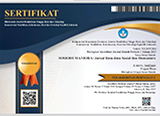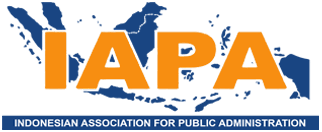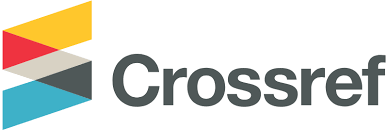THE HISTORY OF WEAVING CRAFTS IN MUNA
Abstract
The objectives of this study are: (1) to explain the history of the origins of the Muna weaving craft, (2) The process of making Muna woven fabrics, (3) The function of woven fabrics in Muna society. This study used historical method and a descriptive qualitative approach. The number of respondents was 15 weaving craftsmen. The results of this study explained that: (1) the history of the origin of the Muna weaving craft and this craft is one of their activities used in certain events. (2) The craft was carried out in two stages in weaving and using two energies, namely the straightening stage (desoro) and the weaving stage (domooru). (3) Weaving craft in Muna society has aesthetic, symbolic, religious, social status for the men, women, and children.
Keywords
Full Text:
PDFReferences
Apriliasti, S. (2013). Makna Simbolis Pakaian Adat Pengantin Suku Sasak Lombok, Nusa Tenggara Barat. Universitas Negeri Yogyakarta.
Arisal, Agustang, A., & Syukur, M. (2020). Kain Tenun “Kamooru” di Kabupaten Muna (1990-2019). Phinisi Integration Review, 4(1), 73–83.
Covreur, J. (2001). Sejarah dan Kebudayaan Kerajaan Muna. Kupang: Artha Wacana Press.
Elyta, E. & Razak, A. (2019). The Role of Weavers Woman in Strengthening Nationalism Case Study in Sajingan Besar Frontier, Indonesia. Sosiohumaniora, 21(1), 40. https://doi.org/10.24198/sosiohumaniora.v21i1.19285
Erwin, T.L. & Joko. (2016). Makna Simbolik Benda Adat Pinangan (kafeena) Dalam Pernikahan Masyarakat etnis Muna. Ilmu Komunikasi UHO, 1–13.
Febriani, T. & Efi, A. (2020). Tenunan Songket Balai Panjang (Studi Kasus di Sentra Tenunan Balai Panjang Kel. Balai Panjang Kec. Payakumbuh Selatan). Jurnal Kapita Selekta Geografi, 3(1), 17–21.
Habibah, J. & Efi, A. (2019). Studi Kasus Motif Tenun Sipirok di Desa Aek Bayur Kota Padang Sidimpuan. Jurnal Kapita Selekta Geografi, 2(7), 64–72.
Jamiludin., Idris, R. & Samad, S. (2016). Weaving Crafts on Muna Community (A Case Study of the Role of Human Capital and Social Capital in Cultural Reproduction of Weaving at Muna Regency). Mediterranean Journal of Social Sciences, 7(3), 53–61. https://doi.org/10.5901/mjss.2016.v7n3s1p53
Karisma, Y., Susanto, E.S., & Hartina, L. (2020). Rancang Bangun Sistem Informasi Penjualan Kain Tenun(Kre Alang) Berbasis Web. JINTEKS (Jurnal Informatika Teknologi Dan Sains), 2(3), 152–158.
Kistanto, N. H. (2015). Tentang Konsep Kebudayaan. Sabda: Jurnal Kajian Kebudayaan, 10(2), 1–11.
Liliweri, A. (2014). Pengantar Studi Kebudayaan. Bandung: Ujung Berung.
Lisnawati. (2016). Makna Tuturan Ritual Kabhasi pada Masyarakat Muna. Junal Bastra, 3(3), 1–11. https://doi.org/http://dx.doi.org/10.36709/jb.v3i3.2298
Melamba, B. (2012). Sejarah dan Ragam Hias Pakaian Adat Tolaki di Sulawesi Tenggara. MOZAIK: Jurnal Ilmu Humaniora, 12(2), 193–209.
Moeliono, A.M. (2002). Kamus Besar Bahasa Indonesia. Jakarta: Depdiknas.
Moleong, L.J. (2007). Metodologi Penelitian Kualitatif. Bandung: Remaja Rosdakarya.
Muchtar, R. (2009). Harmonisasi Agama dan Budaya di Indonesia. Jakarta: Balai Penelitian dan Pengembangan Agama.
Nero, A., Sofianto, K., Sutirman, M. & Suganda, D. (2019). Seni Bordir Tasikmalaya Dalam Konstelasi Estetik Dan Identitas. Patanjala : Jurnal Penelitian Sejarah Dan Budaya, 11(1), 81. https://doi.org/10.30959/patanjala.v11i1.476
Nsaha, L.O. (1979). Aneka Budaya Daerah Sulawesi Tenggara. Kendari.
Nurcahyani, L. (2018). Strategi Pengembangan Produk Kain Tenun Ikat Sinta. Jurnal Pendidikan Dan Kebudayaan, 3(1), 56. https://doi.org/10.24832/jpnk.v3i1.530
Saadah, S. & Efi, A. (2020). Pengaruh Perbedaan Mordan Terhadap Hasil Pencelupan Pada Bahan Katun Menggunakan Ekstrak Kulit Buah Kopi (Coffea). Jurnal Kapita Selekta Geografi, 3, 10–16.
Santoso, R. (2011). Transformasi Sosial di Pedesaan: Studi Fenomenologis Proses Pendidikan dan Pemberdayaan Masyarakat. Jurnal Kependidikan, 41(1), 1–16.
Setiawan, I. (2019). Akulturasi Dalam Tradisi Lisan Maca Syekh Di Kabupaten Pandeglang. Patanjala: Jurnal Penelitian Sejarah Dan Budaya, 11(1), 49. https://doi.org/10.30959/patanjala.v11i1.481
Soekanto. (1993). Sosiologi Suatu Pengantar. Jakarta: Pharadya Paramitha.
Sofyan, A.N., Sofianto, K., Sutirman, M. & Suganda, D. (2018). Seni Kerajinan Kelom Geulis Di Kota Tasikmalaya Sebagai Pelengkap Fashion Wanita. Sosiohumaniora, 20(2), 132–137. https://doi.org/10.24198/sosiohumaniora.v20i2.13968
Syukur, M., Dharmawan, A.H., Sunito, S., Damanhuri, D.S., Sosiologi, S. & Negeri, U. (2014). Transformasi Penenun Bugis-Wajo Menuju Era Modernitas. 63–77.
Syukur, M., Dharmawan, A.H., Unito, S.S., & Damanhuri, D. S. (2013). Kearifan Lokal dalam Sistem Sosial Ekonomi Masyarakat Penenun Bugis-Wajo. MUDRA Jurnal Seni Budaya, 28(2), 129–142.
Wikandia, R. (2016). Pelestarian dan Pengembangan Seni Ajeng Sinar Pusaka pada Penyambutan Pengantin Khas Karawang. Panggung, 26(1), 58–69. https://doi.org/10.26742/panggung.v26i1.162
DOI: https://doi.org/10.24198/sosiohumaniora.v24i2.32661
Refbacks
- There are currently no refbacks.
Copyright (c) 2022 Sosiohumaniora

This work is licensed under a Creative Commons Attribution-ShareAlike 4.0 International License.
Sosiohumaniora Indexed By:
 Creation is distributed below Creative Commons Attribution-ShareAlike 4.0 International License.
Creation is distributed below Creative Commons Attribution-ShareAlike 4.0 International License.
Published By:
Faculty of Social and Political Sciences, Universitas Padjadjaran
Dean's Building 2nd Floor, Jalan Ir. Soekarno Km. 21 Jatinangor, Sumedang 45363
Email: jurnal.sosiohumaniorafisip@gmail.com

















